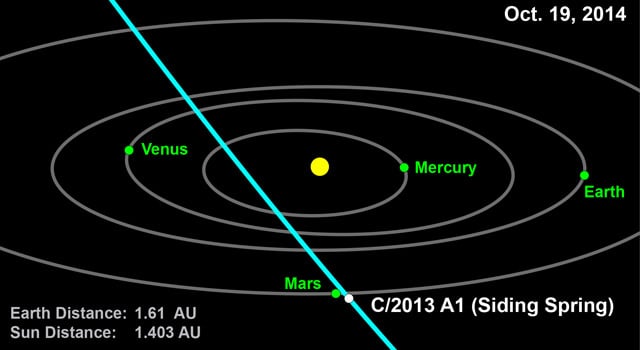NASA's Near-Earth Object Office says that new observations of comet C/2013 A1 (Siding Spring) have allowed further refinements of the comet's orbit, helping to determine the chances it could hit Mars in October of 2014. Shortly after its discovery in December 2012, astronomers thought there was an outside chance that a newly discovered comet might be on a collision course with Mars.
While the latest orbital plot places the comet's closest approach to Mars slightly closer than previous estimates, the new data now significantly reduces the probability the comet will impact the Red Planet, JPL said, from about 1 in 8,000 to about 1 in 120,000.
The closest approach is now estimated at about 68,000 miles (110,000 kilometers). The most previous estimates had it whizzing by at 186,000 miles (300,000 kilometers).
The latest estimated time for close approach to Mars is about 11:51 a.m. PDT (18:51 UTC) on Oct. 19, 2014. At the time of closest approach, the comet will be on the sunward side of the planet.
The comet was discovered in the beginning of 2013 by comet-hunter Robert McNaught at the Siding Spring Observatory in New South Wales, Australia. When the discovery was initially made, astronomers at the Catalina Sky Survey in Arizona looked back over their observations to find "prerecovery" images of the comet dating back to Dec. 8, 2012. These observations placed the orbital trajectory of comet C/2013 A1 right through Mars orbit on Oct. 19, 2014.
JPL says future observations of the comet are expected to refine the orbit further. The most up-to-date close-approach data can be found at
JPL's Small Body Database.
Source:
JPL
 Universe Today
Universe Today
